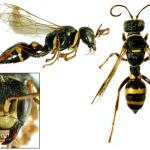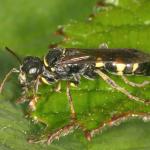A distinctive wasp with its yellow-banded, waisted abdomen combined with distinctive dark smudges on the forewing. Previously known as Gorytes bicinctus.
Recorded widely but sparingly over southern England from Cornwall to Kent and north to Buckinghamshire, Hertfordshire and Norfolk; also the Channel Islands (Jersey). The species is not included in Lomholdt's 1975-76 and 1984 Fennoscandian books. However, Bitsch et al. (1997) state that it is found over much of Europe, southwards to Spain and Italy, and eastwards to the Ukraine and the Altai mountains in Russia.
Listed as Notable B by Falk (1991) (now known as Scarce (Nb)). It appears to be scarce in most parts of its range, though it also seems to be an elusive species. For example, in Kent, where the cleptoparasite Nysson trimaculatus is assumed to rely mainly on this species (as its other known host Gorytes quadrifasciatus is rare in that county), there are many sites where only the Nysson has been found.
Associated with scrubby or brambly places in sunny location s on light soils. Sites include heathland, rough grassland, parkland, coastal landslips and soft rock cliffs, coastal dunes and occasionally suburban gardens and wood land clearings. Males have been reported 'swarming' on the foliage of trees and shrubs by several recorders.
Univoltine; June to early October.
The prey consists of cicadellid and cercopid bugs (Richards, 1980). Both Philaenus spumarius and Aphrophora alni are cited in Bitsch et al. (1997).
The ecology of this species is poorly known, but nesting is likely to occur in light soils, possibly in areas exposed to sunshine.
No British flower visiting data have been obtained, though related species frequently visit umbellifers. Bitsch et al. list various umbellifers in France, including wild angelica and wild parsnip.
The scarce nyssonine wasp Nysson trimaculatus is thought to attack L. bicinctus in southern counties such as Kent. However, the Nysson also parasitises Gorytes quadrifasciatus in parts of its range; exclusively so in the Midlands and northern England.
2001



